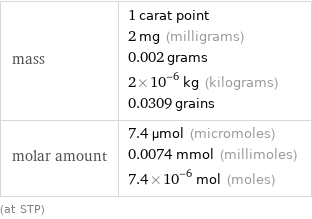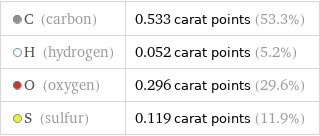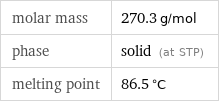Input interpretation

1 carat point of (R)-(-)-dihydro-5-(p-tolylsulfonyloxymethyl)-2(3 H)-furanone
Basic properties for 1 carat point

mass | 1 carat point 2 mg (milligrams) 0.002 grams 2×10^-6 kg (kilograms) 0.0309 grains molar amount | 7.4 µmol (micromoles) 0.0074 mmol (millimoles) 7.4×10^-6 mol (moles) (at STP)
Mass composition for 1 carat point

C (carbon) | 0.533 carat points (53.3%) H (hydrogen) | 0.052 carat points (5.2%) O (oxygen) | 0.296 carat points (29.6%) S (sulfur) | 0.119 carat points (11.9%)

Mass composition for 1 carat point
Lewis structure

Draw the Lewis structure of (R)-(-)-dihydro-5-(p-tolylsulfonyloxymethyl)-2(3 H)-furanone. Start by drawing the overall structure of the molecule, ignoring potential double and triple bonds: Count the total valence electrons of the carbon (n_C, val = 4), hydrogen (n_H, val = 1), oxygen (n_O, val = 6), and sulfur (n_S, val = 6) atoms: 12 n_C, val + 14 n_H, val + 5 n_O, val + n_S, val = 98 Calculate the number of electrons needed to completely fill the valence shells for carbon (n_C, full = 8), hydrogen (n_H, full = 2), oxygen (n_O, full = 8), and sulfur (n_S, full = 8): 12 n_C, full + 14 n_H, full + 5 n_O, full + n_S, full = 172 Subtracting these two numbers shows that 172 - 98 = 74 bonding electrons are needed. Each bond has two electrons, so in addition to the 33 bonds already present in the diagram we expect to add 4 bonds. To minimize formal charge oxygen wants 2 bonds and carbon wants 4 bonds. Identify the atoms that want additional bonds and the number of electrons remaining on each atom: Add 4 bonds by pairing electrons between adjacent highlighted atoms. Additionally, atoms with large electronegativities can minimize their formal charge by forcing atoms with smaller electronegativities on period 3 or higher to expand their valence shells. The electronegativities of the atoms are 2.20 (hydrogen), 2.55 (carbon), 2.58 (sulfur), and 3.44 (oxygen). Because the electronegativity of sulfur is smaller than the electronegativity of oxygen, expand the valence shell of sulfur to 6 bonds. Therefore we add a total of 6 bonds to the diagram. Note that the six atom ring is aromatic, so that the single and double bonds may be rearranged: Answer: | |
Chemical names and formulas
![formula | C_12H_14O_5S Hill formula | C_12H_14O_5S name | (R)-(-)-dihydro-5-(p-tolylsulfonyloxymethyl)-2(3 H)-furanone IUPAC name | 4-methylbenzenesulfonic acid [(2R)-5-oxo-2-tetrahydrofuranyl]methyl ester](../image_source/6a45e8ade69d1f2abeac0a8e8142972b.png)
formula | C_12H_14O_5S Hill formula | C_12H_14O_5S name | (R)-(-)-dihydro-5-(p-tolylsulfonyloxymethyl)-2(3 H)-furanone IUPAC name | 4-methylbenzenesulfonic acid [(2R)-5-oxo-2-tetrahydrofuranyl]methyl ester
Substance properties

molar mass | 270.3 g/mol phase | solid (at STP) melting point | 86.5 °C
Units
